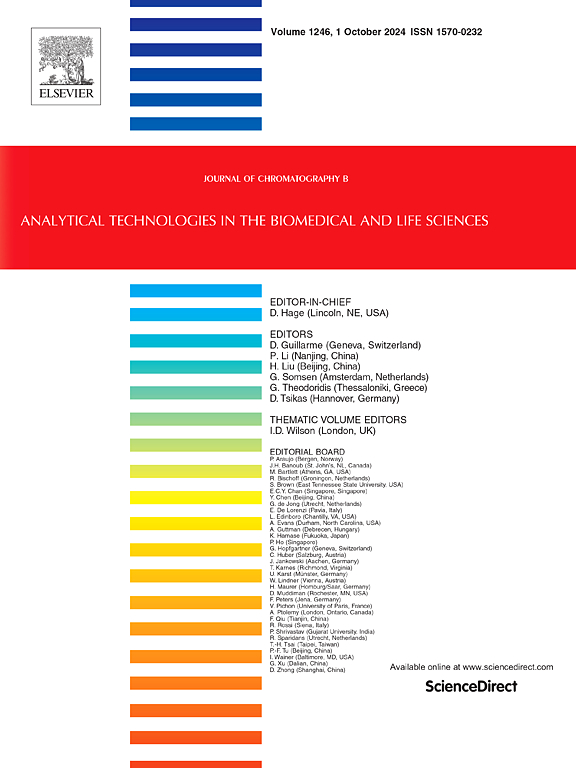Integrated GC and tri-GPC methods for purity evaluation and molecular characterization of key organic ingredients in composite solid propellants
IF 2.8
3区 医学
Q2 BIOCHEMICAL RESEARCH METHODS
引用次数: 0
Abstract
This study highlights the critical need to assess the purity of key organic ingredients in composite solid propellants (CSP) for satellite launch vehicles. Components such as Dioctyl Adipate (DOA), Toluene Diisocyanate (TDI), Phenyl-beta-naphthylamine (PBNA), Trimethylolpropane (TMP), Butanediol (BDO) and Hydroxyl-terminated Polybutadiene (HTPB) significantly impact propellant properties, necessitating stringent quality control.
A unified Gas Chromatography (GC) method was developed for the rapid and reliable analysis of DOA, TDI, PBNA, TMP and BDO. Key parameters such as temperature programming and carrier gas flow rates were optimized and ensured resolution of peaks and impurity detection. The method demonstrated excellent linearity and repeatability, achieving low Relative Standard Deviation (RSD) values for retention times and peak areas. It was successfully applied across multiple batches and sources, accurately determining TDI isomer ratios and TMP-BDO mixture ratios in Ambi-link.
For HTPB, a Triple Detection Gel Permeation Chromatography (GPC) method was established to analyse molecular weights, polydispersity index (PDI), intrinsic viscosity and molecular sizes. This approach enhanced analytical precision while reducing time and labour, offering deeper insights into polymer behaviour and its correlation with propellant properties.
By integrating GC and GPC methodologies, this study provides a robust, efficient framework for evaluating CSP ingredients, minimizing hazardous chemical use and improving quality assurance. This advanced characterization approach contributes to optimizing solid rocket propellant formulations and improving their overall performance.

综合GC和三gpc方法对复合固体推进剂中关键有机成分的纯度评价和分子表征
这项研究强调了评估卫星运载火箭复合固体推进剂(CSP)中关键有机成分纯度的迫切需要。己二酸二辛酯(DOA)、甲苯二异氰酸酯(TDI)、苯基-萘胺(PBNA)、三甲基丙烷(TMP)、丁二醇(BDO)和端羟基聚丁二烯(HTPB)等成分对推进剂的性能有显著影响,需要严格的质量控制。建立了一种统一的气相色谱(GC)方法,用于快速、可靠地分析DOA、TDI、PBNA、TMP和BDO。优化了温度规划和载气流速等关键参数,保证了峰的分辨和杂质的检测。该方法具有良好的线性和重复性,保留时间和峰面积均具有较低的相对标准偏差(RSD)。它成功地应用于多个批次和来源,准确地测定了ambio -link中的TDI异构体比率和TMP-BDO混合物比率。对于HTPB,建立了三重检测凝胶渗透色谱法(GPC)来分析其分子量、多分散性指数(PDI)、特征粘度和分子大小。这种方法提高了分析精度,同时减少了时间和劳动,提供了对聚合物行为及其与推进剂性能的相关性的更深入的了解。通过整合GC和GPC方法,本研究为CSP成分评估提供了一个强大、有效的框架,最大限度地减少有害化学物质的使用,提高质量保证。这种先进的表征方法有助于优化固体火箭推进剂配方,提高其整体性能。
本文章由计算机程序翻译,如有差异,请以英文原文为准。
求助全文
约1分钟内获得全文
求助全文
来源期刊

Journal of Chromatography B
医学-分析化学
CiteScore
5.60
自引率
3.30%
发文量
306
审稿时长
44 days
期刊介绍:
The Journal of Chromatography B publishes papers on developments in separation science relevant to biology and biomedical research including both fundamental advances and applications. Analytical techniques which may be considered include the various facets of chromatography, electrophoresis and related methods, affinity and immunoaffinity-based methodologies, hyphenated and other multi-dimensional techniques, and microanalytical approaches. The journal also considers articles reporting developments in sample preparation, detection techniques including mass spectrometry, and data handling and analysis.
Developments related to preparative separations for the isolation and purification of components of biological systems may be published, including chromatographic and electrophoretic methods, affinity separations, field flow fractionation and other preparative approaches.
Applications to the analysis of biological systems and samples will be considered when the analytical science contains a significant element of novelty, e.g. a new approach to the separation of a compound, novel combination of analytical techniques, or significantly improved analytical performance.
 求助内容:
求助内容: 应助结果提醒方式:
应助结果提醒方式:


